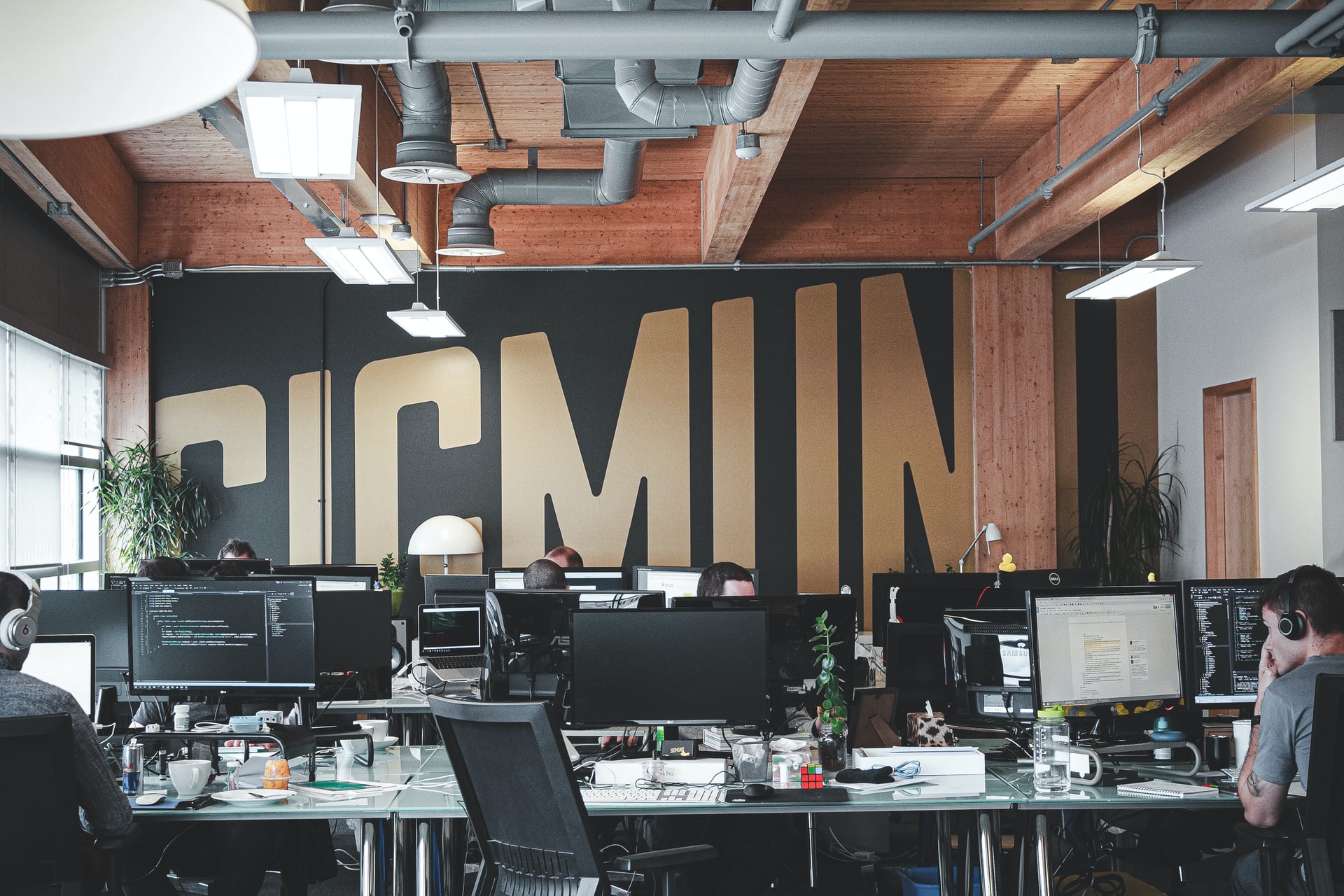Everyone is going hybrid.
But that means a lot of different things. We know what fully distributed means, and we know what fully in-office every day means. But the middle is quite muddy. Is there just one hybrid business model, or are there thousands?
Team members are split on their expectations as well. Over 70 percent of workers want flexible remote work options to continue, but over 65 percent are craving more in-person time with their teams.
As you move in from the ends of the spectrum, there are two very different hybrid work models. The central difference is what is the core or nucleus of your business.
As you consider reopening your office, be very clear about which hybrid business model you plan on offering to your team.
What is a hybrid business model?
A hybrid business model is one that blends the in-person and remote work experience. There is a wide range of models that can be considered hybrid. The core differences are where the HQ is, how much flexibility workers have, how often they are mandated to be together, and how any physical space is used.
The four types of hybrid business models
1. Office-based with limited flexibility
Your physical office is your headquarters. It is the central source of truth. Everything important happens in the office: meetings, discussions, training, announcements, etc. The physical office is the primary way teams collaborate, measure productivity, think about leadership, and build culture. If you aren’t in the office every day, you are going to miss out.
This model still uses a lot of digital tools, but the real data lives in the shared knowledge of the hive. For example, the truth about what happened in a meeting is not in the notes, but in the shared context from everyone who attended.
The expectation in Model 1 is that you need to be plugged into the HQ every day. There is some allowance for things like snow days, being on the road, or caring for a sick kid. However, these are exceptions. If you aren’t in the office, it’s your responsibility to catch up on what you missed.
2. Office-based with generous flexibility
The physical office is still the true HQ. The same basic premises from Model 1 still apply.
However, this hybrid business model allows people to work from home one or two days a week. People can work independently on tasks that don’t require immediate collaboration. If you need to shift to focus work mode for a long stretch and hammer out a load of payroll updates, you can stay home. It also gives a weekly reprieve to commuting.
Model 2 gets people together when they need to realign. Workplaces that use a Model 2 hybrid business model often rely on both digital tools and the office as the central source of truth.
3. Digital-based with an office
In Model 3, the central source of truth is the technological core of your digital workplace. The entire business runs on digital tools for collaboration, productivity, culture, and leadership. Every major system has been decoupled from the physical office.
This is a “digital-first” hybrid business model. If a team needs realignment, they go to their strategy execution tools, or switch to synchronous digital conversations.
In Model 3, the company still has a dedicated physical office, but it is used as a feature, not core to the business. Instead of asking why people might want to work from home, it asks why they need to be together.
Physical space is used for:
- People who don’t have a good work-from-home setup
- Meeting clients/customers
- Scheduled collaboration meetings that benefit from the extra fidelity of being in person
- Regular gatherings such as a monthly all-hands meeting
4. Digital-based with no dedicated office
In Model 4, the team has no permanent office. Everyone is distributed and there is no physical headquarters. The central source of truth is completely digital.
Teams rent physical space when required. Team members work from home or from co-working locations paid for by the company. The team might gather physically as often as once a month, or as little as once a year.
Hot takes on your hybrid business model
A shift from Model 1 to 2 will likely fail over time
The biggest problem with the shift from Model 1 to Model 2 is that leaders are not required to change their thinking. The extra flexibility is seen as benevolence, but leaders will quickly grow tired if they can’t immediately reach people. Because the central source of truth is the office, not being there for a day is a liability for team members who want to grow. They lose context every day they are not in the office. Leaders who aren’t challenged to move beyond presenteeism will grow frustrated. Eventually, leaders will require everyone to come back to the office every day.
Most leaders moving to Model 2 view it as a compromise. They want people in the office, but feel they need to offer more flexibility. As a result, when things get hard for leaders, they will consider it their prerogative to pull back on the ‘freedom’ they so kindly offered.

Model 2 requires more clarity than most teams are willing to create
To successfully move to this model, there are a lot of questions to answer about a hybrid workplace.
- Does everyone need to be in the office on the same days?
- Is there flexibility in what hours you are expected to work and be available?
- If there is a meeting on a day when someone isn’t in the office, how do you hold hybrid meetings?
- How do you avoid creating a bias towards people who are in the office every day?
Model 2 can work, but it requires very detailed working agreements and a lot more clarity than leaders are used to providing.
Remote vs. distributed
The correct term for team members in the first two hybrid work models is ‘remote’ because they are away from HQ. In Model 3 and Model 4, the correct term is ‘distributed’. They are fully present in the HQ (i.e. the digital core), just not physically co-located.
Multiple sources of truth leads to chaos
Your eyebrows should have gone up for Model 2 at this line:
“Workplaces who use a Model 2 hybrid business model often rely on both digital tools and the office as the central source of truth.”
That doesn’t work. You need to have one source of truth or else people get confused and frustrated.

The gap between Model 2 and Model 3 is massive
This is not just creating a remote work policy. Shifting to Model 3 is a complete paradigm change. Don’t say you are going to do it unless you are willing to decouple EVERY work system from the physical office.
Model 2 can create two classes of team members
Very quickly, you’ll have the every-day-office people, and the occasional office people. The gap between the two will grow ever wider unless you plan for it not to. People who are in the office every day must build an inclusive mindset to share additional context. However, they may see this as a burden and wonder why they need to work harder for other people who are getting “perks”. This road leads right back to Model 1.
Neither Model 2 nor 3 has a lot of good role models
In The Before, most companies were Model 1. There were a few Model 4 companies who achieved rockstar status and published a lot of material on how to copy their systems. But there was not a lot out there on Model 2 or 3.
You’ve likely never tried either of these models. They are just as brand new as adjusting to a pandemic. They will take experimentation and learning from mistakes. We’ll have a lot of good resources to learn from 5 years from now, but you’ll need to start creating that wisdom now.
You will lose people no matter what
Some people really want Model 1. They want to be in the office. If you announce you are going to Model 3 or 4, they will leave.
Other people never want to work in Model 1 again. If you announce you want everyone back in the office, they will leave.
You can’t stop this. Find the people who will work best in the model that you commit to.
The one way to tell which model you are in
You can come up with all the policies you want. If the boss is in the office every day, you are Model 1. If the boss only shows up a few days, you are Model 2. If the boss hardly ever shows up, you are Model 3 or 4.
Actions speak louder than words. If you want to be a Model 2+ company, as the boss, you have to commit to not being in the office every day and learn what it’s like.
The worst hybrid business model
…is the undefined one.
There’s no perfect hybrid work model. It all depends on your business model, your history, your biases, and how much you are willing to change. Each model has benefits and drawbacks.
But if you just say, “We are going hybrid,” and leave it at that, everyone will suffer. Be very clear in your communication and define as much as possible. Add more clarity as you get deeper in your hybrid work model and encounter new issues.
This is the great challenge of the post-pandemic workplace. Great leaders will commit to a path and adjust it as necessary. Find the model that works for you to best embrace the new digital age.
Everyone is going hybrid.
But that means a lot of different things. We know what fully distributed means, and we know what fully in-office every day means. But the middle is quite muddy. Is there just one hybrid business model, or are there thousands?
Team members are split on their expectations as well. Over 70 percent of workers want flexible remote work options to continue, but over 65 percent are craving more in-person time with their teams.
As you move in from the ends of the spectrum, there are two very different hybrid work models. The central difference is what is the core or nucleus of your business.
As you consider reopening your office, be very clear about which hybrid business model you plan on offering to your team.
What is a hybrid business model?
A hybrid business model is one that blends the in-person and remote work experience. There is a wide range of models that can be considered hybrid. The core differences are where the HQ is, how much flexibility workers have, how often they are mandated to be together, and how any physical space is used.
The four types of hybrid business models
1. Office-based with limited flexibility
Your physical office is your headquarters. It is the central source of truth. Everything important happens in the office: meetings, discussions, training, announcements, etc. The physical office is the primary way teams collaborate, measure productivity, think about leadership, and build culture. If you aren’t in the office every day, you are going to miss out.
This model still uses a lot of digital tools, but the real data lives in the shared knowledge of the hive. For example, the truth about what happened in a meeting is not in the notes, but in the shared context from everyone who attended.
The expectation in Model 1 is that you need to be plugged into the HQ every day. There is some allowance for things like snow days, being on the road, or caring for a sick kid. However, these are exceptions. If you aren’t in the office, it’s your responsibility to catch up on what you missed.
2. Office-based with generous flexibility
The physical office is still the true HQ. The same basic premises from Model 1 still apply.
However, this hybrid business model allows people to work from home one or two days a week. People can work independently on tasks that don’t require immediate collaboration. If you need to shift to focus work mode for a long stretch and hammer out a load of payroll updates, you can stay home. It also gives a weekly reprieve to commuting.
Model 2 gets people together when they need to realign. Workplaces that use a Model 2 hybrid business model often rely on both digital tools and the office as the central source of truth.
3. Digital-based with an office
In Model 3, the central source of truth is the technological core of your digital workplace. The entire business runs on digital tools for collaboration, productivity, culture, and leadership. Every major system has been decoupled from the physical office.
This is a “digital-first” hybrid business model. If a team needs realignment, they go to their strategy execution tools, or switch to synchronous digital conversations.
In Model 3, the company still has a dedicated physical office, but it is used as a feature, not core to the business. Instead of asking why people might want to work from home, it asks why they need to be together.
Physical space is used for:
- People who don’t have a good work-from-home setup
- Meeting clients/customers
- Scheduled collaboration meetings that benefit from the extra fidelity of being in person
- Regular gatherings such as a monthly all-hands meeting
4. Digital-based with no dedicated office
In Model 4, the team has no permanent office. Everyone is distributed and there is no physical headquarters. The central source of truth is completely digital.
Teams rent physical space when required. Team members work from home or from co-working locations paid for by the company. The team might gather physically as often as once a month, or as little as once a year.
Hot takes on your hybrid business model
A shift from Model 1 to 2 will likely fail over time
The biggest problem with the shift from Model 1 to Model 2 is that leaders are not required to change their thinking. The extra flexibility is seen as benevolence, but leaders will quickly grow tired if they can’t immediately reach people. Because the central source of truth is the office, not being there for a day is a liability for team members who want to grow. They lose context every day they are not in the office. Leaders who aren’t challenged to move beyond presenteeism will grow frustrated. Eventually, leaders will require everyone to come back to the office every day.
Most leaders moving to Model 2 view it as a compromise. They want people in the office, but feel they need to offer more flexibility. As a result, when things get hard for leaders, they will consider it their prerogative to pull back on the ‘freedom’ they so kindly offered.

Model 2 requires more clarity than most teams are willing to create
To successfully move to this model, there are a lot of questions to answer about a hybrid workplace.
- Does everyone need to be in the office on the same days?
- Is there flexibility in what hours you are expected to work and be available?
- If there is a meeting on a day when someone isn’t in the office, how do you hold hybrid meetings?
- How do you avoid creating a bias towards people who are in the office every day?
Model 2 can work, but it requires very detailed working agreements and a lot more clarity than leaders are used to providing.
Remote vs. distributed
The correct term for team members in the first two hybrid work models is ‘remote’ because they are away from HQ. In Model 3 and Model 4, the correct term is ‘distributed’. They are fully present in the HQ (i.e. the digital core), just not physically co-located.
Multiple sources of truth leads to chaos
Your eyebrows should have gone up for Model 2 at this line:
“Workplaces who use a Model 2 hybrid business model often rely on both digital tools and the office as the central source of truth.”
That doesn’t work. You need to have one source of truth or else people get confused and frustrated.

The gap between Model 2 and Model 3 is massive
This is not just creating a remote work policy. Shifting to Model 3 is a complete paradigm change. Don’t say you are going to do it unless you are willing to decouple EVERY work system from the physical office.
Model 2 can create two classes of team members
Very quickly, you’ll have the every-day-office people, and the occasional office people. The gap between the two will grow ever wider unless you plan for it not to. People who are in the office every day must build an inclusive mindset to share additional context. However, they may see this as a burden and wonder why they need to work harder for other people who are getting “perks”. This road leads right back to Model 1.
Neither Model 2 nor 3 has a lot of good role models
In The Before, most companies were Model 1. There were a few Model 4 companies who achieved rockstar status and published a lot of material on how to copy their systems. But there was not a lot out there on Model 2 or 3.
You’ve likely never tried either of these models. They are just as brand new as adjusting to a pandemic. They will take experimentation and learning from mistakes. We’ll have a lot of good resources to learn from 5 years from now, but you’ll need to start creating that wisdom now.
You will lose people no matter what
Some people really want Model 1. They want to be in the office. If you announce you are going to Model 3 or 4, they will leave.
Other people never want to work in Model 1 again. If you announce you want everyone back in the office, they will leave.
You can’t stop this. Find the people who will work best in the model that you commit to.
The one way to tell which model you are in
You can come up with all the policies you want. If the boss is in the office every day, you are Model 1. If the boss only shows up a few days, you are Model 2. If the boss hardly ever shows up, you are Model 3 or 4.
Actions speak louder than words. If you want to be a Model 2+ company, as the boss, you have to commit to not being in the office every day and learn what it’s like.
The worst hybrid business model
…is the undefined one.
There’s no perfect hybrid work model. It all depends on your business model, your history, your biases, and how much you are willing to change. Each model has benefits and drawbacks.
But if you just say, “We are going hybrid,” and leave it at that, everyone will suffer. Be very clear in your communication and define as much as possible. Add more clarity as you get deeper in your hybrid work model and encounter new issues.
This is the great challenge of the post-pandemic workplace. Great leaders will commit to a path and adjust it as necessary. Find the model that works for you to best embrace the new digital age.
)
)
)







